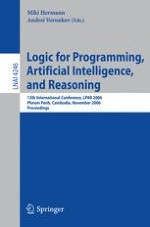
2006 | OriginalPaper | Chapter
Higher-Order Termination: From Kruskal to Computability
Authors : Frédéric Blanqui, Jean-Pierre Jouannaud, Albert Rubio
Published in: Logic for Programming, Artificial Intelligence, and Reasoning
Publisher: Springer Berlin Heidelberg
Activate our intelligent search to find suitable subject content or patents.
Select sections of text to find matching patents with Artificial Intelligence. powered by
Select sections of text to find additional relevant content using AI-assisted search. powered by
Termination is a major question in both logic and computer science. In logic, termination is at the heart of proof theory where it is usually called strong normalization (of cut elimination). In computer science, termination has always been an important issue for showing programs correct. In the early days of logic, strong normalization was usually shown by assigning ordinals to expressions in such a way that eliminating a cut would yield an expression with a smaller ordinal. In the early days of verification, computer scientists used similar ideas, interpreting the arguments of a program call by a natural number, such as their size. Showing the size of the arguments to decrease for each recursive call gives a termination proof of the program, which is however rather weak since it can only yield quite small ordinals. In the sixties, Tait invented a new method for showing cut elimination of natural deduction, based on a
predicate
over the set of terms, such that the membership of an expression to the predicate implied the strong normalization property for that expression. The predicate being defined by induction on types, or even as a fixpoint, this method could yield much larger ordinals. Later generalized by Girard under the name of
reducibility
or
computability candidates
, it showed very effective in proving the strong normalization property of typed lambda-calculi with polymorphic types, dependent types, inductive types, and finally a cumulative hierarchy of universes. On the programming side, research on termination shifted from programming to executable specification languages based on rewriting, and concentrated on automatable methods based on the construction on well-founded orderings of the set of terms. The milestone here is Dershowitz’s
recursive path ordering
(RPO), in the late seventies, whose well-foundedness proof is based on a powerful combinatorial argument, Kruskal’s tree theorem, which also yields rather large ordinals. While the computability predicates must be defined for each particular case, and their properties proved by hand, the recursive path ordering can be effectively automated.